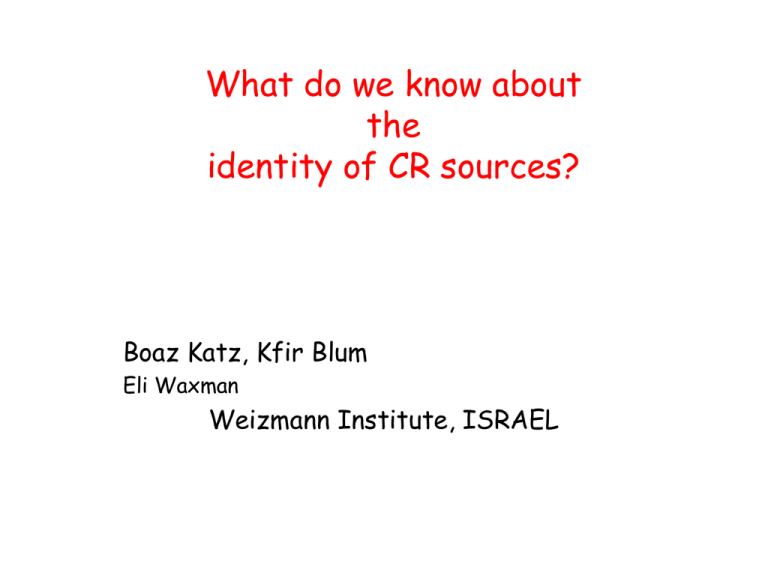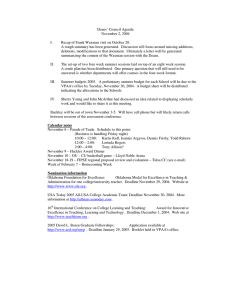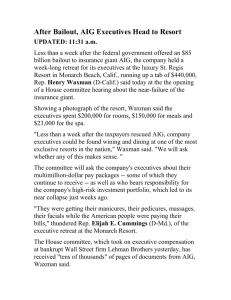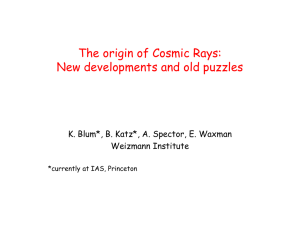Eli Waxman
advertisement

What do we know about
the
identity of CR sources?
Boaz Katz, Kfir Blum
Eli Waxman
Weizmann Institute, ISRAEL
The cosmic-ray spectrum & Composition
log [dJ/dE]
E-2.7
Galactic
Protons
E-3
Source: Supernovae(?)
X-Galactic (?)
Heavy Nuclei
Source?
Light Nuclei?
Lighter
Source?
1
106
1010
Cosmic-ray E [GeV]
[Blandford & Eichler, Phys. Rep. 87;
Axford, ApJS 94;
Nagano & Watson, Rev. Mod. Phys. 00]
Intra-cluster CRs
• Observed in radio, HXR
• Will not be discussed here
• See D. Kushnir’s talk:
[arXiv:0903.2271, 0903.2275, 0905.1950]
* Likely origin- Accretion shocks
* Predictions for Fermi, TeV (HESS, MAGIC)
Galactic CR sources: Constraints
• Max e>~1015eV
• Energy production rate
LG,CR~(AdiskhCR)UCR/tCR
* UCR~1 eV/cm3,
* Propagation: 2nd-ary (& primary) composition
0.5
j i ni i
e
/
Z
2
ni (e ) n j
g/cm
S sec (e / Z ) , S sec 8.7
m p
10GeV
j i m p
LG,CR~cAdiskUCR(Sdisk/Ssec)~1049.5erg/100yr
[Blandford & Eichler, Phys. Rep. 87;
Axford, ApJS 94]
Galactic CR sources: SNe?
• Motivation for SNe as sources:
* LG,CR~10-1.5 LG,SN
* Max e~1015eV
* e- acceleration to 1015eV from X emission
[e.g. Koyama et al. 95]
• TeV photons from SNRs
(RXJ1713.7-3946,RXJ0852.0-4622)
[e.g. Aharonian et al. 04--07]
* Claim: must be due to pp pion production
Confirms CR ion production
TeV must be due to e- IC
• ppp origin in contradiction with radio, thermal-X
(non detection of thermal X n<~0.1/cm3):
nLn pp
10 2
nLn Therm.Berm.
nLn pp n e / p 1 nLn TeV
2
5
100
3
nLn Synch. 0.1 / cm 10
nLn 1GHz
• TeV consistent with e- IC, including “cutoffs”:
hn Synch.,c
1
n
1
keV ,
3
0.1 / cm
hn IC ,c
1
n
10
TeV
3
0.1 / cm
• Claims RE e- IC inconsistency:
Detailed spectral shape near hnc, where
theoretical predictions are highly uncertain
[Katz & Waxman 07]
SNR TeV lessons
• Search at high n SNRs:
Strong Thermal X, weak non-Thermal
1
nLn pp
e / p n
3 2
3
nLn IC 1GeV 10 1 / cm
• Difficult to prove pp based on EM obs.
Highly simplified, phenomenological models
(and plenty of room for complications:
inhomogeneous plasma, particle spectra…)
[Katz & Waxman 07]
PAMELA: New e+ sources?
103
p/ p
• Apply
anti-p, e+ consistent with
2ndary origin
104
e /(e e )
101
j i ni i
ni (e ) n j
S sec (e / Z )
j i m p m p
f rad
102
10 GeV
100 GeV
• Radiative e+ losses- depend
on propagation in Galaxy
(poorly understood)
* At 20GeV: frad~0.3~f10Be
* Above 20GeV:
If PAMELA correct
slightly rising frad(e)
[Katz, Blum & Waxman 09]
What do we know about >1019eV CRs?
•
•
Max e:
LB>1012 (G2/b) (e/Z 1020eV)2 Lsun
(see Dermer’s talk)
Composition
[Waxman 95, 04]
Composition clues
HiRes 2005
Westerhoff
(Auger) 2009
What do we know about >1019eV CRs?
•
Max e:
LB>1012 (G2/b) (e/Z 1020eV)2 Lsun
•
Composition:
HiRes –protons, Auger- becoming heavier @ 3x1019eV?
!!Uncertain interaction cross sections
•
Energy production rate:
- LB>1012 Lsun & RL=e/eB=40ep,20kpc Likely X-Galactic
Flux & Spectrum
• e2(dN/de)=e2(dQ/de) teff.
(teff. : p + gCMB N + p
Assume: p, dQ/de~(1+z)me-a
log(e2dQ/de) [erg/Mpc2 yr]
cteff [Mpc]
GZK (CMB)
suppression
• >1019.3eV: consistent with
protons, e2(dQ/de) ~1043.7 erg/Mpc3 yr + GZK
[Katz & Waxman 09]
[Waxman 1995; Bahcall & Waxman 03]
• e2(dQ/de) ~Const.: Consistent with shock acceleration
[Reviews: Blandford & Eichler 87; Waxman 06
cf. Lemoine & Revenu 06]
G-XG Transition at 1018eV?
Fine tuning
Inconsistent spectrum
[Katz & Waxman 09]
What do we know about >1019eV CRs?
•
Max e:
LB>1012 (G2/b) (e/Z 1020eV)2 Lsun
•
Composition
HiRes –protons, Auger- becoming heavier
Uncertain interaction cross sections
•
Energy production rate
- LB>1012 Lsun & RL=e/eB=40ep,20kpc Likely X-Galactic
- Consistent with
protons, e2(dQ/de) ~1043.7 erg/Mpc3 yr + GZK
UHE CR sources
• Constraints: - L>1012 (G2/b) Lsun
- e2(dQ/de) ~1043.7 erg/Mpc3 yr
- d(1020eV)<dGZK~100Mpc
!! No L>1012 Lsun at d<dGZK Transient Sources
[Waxman 95, Vietri 95, Milgrom & Usov 95]
• Gamma-ray Bursts (GRBs)
G~ 102.5, Lg~ 1019LSun L/G2 >1012 Lsun
(dn/dVdt)*E~10-9.5 /Mpc3 yr *1053.5erg ~1044 erg/Mpc3 yr [Waxman 95]
Transient: DTg~10s << DTpg ~105 yr
• Active Galactic Nuclei (AGN, Steady):
G~ 101 L>1014 LSun= few brightest
!! Non at d<dGZK Invoke:
* “Dark” (proton only) AGN
* L~ 1014 LSun , Dt~1month flares
(from stellar disruptions)
[Blandford 76; Lovelace 76]
[Boldt & Loewenstein 00]
[Farrar & Gruzinov 08]
Anisotropy
Biased (rsource~rgal for rgal>rgal )
[Kashti & Waxman 08]
• Cross-correlation signal:
Inconsistent with isotropy @ 98% CL (~1.5)
Consistent with LSS
• If anisotropy signal real & no anisotropy at 60EeV/(Z~10)
primaries must be protons
See M. Lemoine’s talk [arXiv:0907.1354]
The GRB “GZK sphere”
• LSS filaments:
D~1Mpc, fV~0.1, n~10-6cm-3, T~0.1keV
eB=(B2/8p/nT~0.01 (B~0.01mG), lB~10kpc
0.3
0
g
p
d / 100Mpc 1/ 2 D f l e 1/ 2
V B B
20
e p / 10 eV
D
2
d / 100Mpc 2
2 d
5
D fV l B e B
Spread ~ Delay ~ ~ 10 yr
20
c
e p / 10 eV
RGRB ~ 0.5 / Gpc 3 yr
lB
N GRBs ( 10 20 eV) ~ 10 2 D 2 fV lBe B
• Prediction:
N GRBs ( 3 10 20 eV ) ~ few
[Waxman 95; Miralda-Escude &
Waxman 96, Waxman 04]
Summary
• Galactic e<1015eV (<1019eV)
- LG,CR~10-1.5 LG,SN & Max e~1015eV (1019eV)
suggest SNR (trans-rel. SN) sources
- TeV from low n, non-thermal X SNR: e- IC
- Search for pp in high n, strong thermal X SNR
pp:IC[@1GeV]~3 (n/1cm3)
* Anti-p, e+ data consistent with 2ndary origin
Prediction: e+/(e++ e-)<0.2+-0.1 up to ~300GeV
PAMELA slightly rising frad(e) [constrain CR prop. Models]
• X-Galactic e>1019eV
- Likely protons, e2(dQ/de) ~1043.7 erg/Mpc3 yr, LB>1012 Lsun
suggest: GRBs [AGN flares?]
- Anisotropy constrains primary composition
• Difficult to uniquely identify sources via EM observations
Search for HE n’s
Back up slides
X-ray filaments
• Claim: X-ray filaments require B>100mG, much
larger than required for IC explanation of TeV
emission (B~10mG).
• Claim based on the assumption:
Filaments due to e- cooling (vs, e.g., B variations).
* No independent support to this assumption;
* X-ray & RADIO filaments (Tycho, SN2006)
inconsistent with this assumption.
What is the e+ excess claim based on?
• On assumptions not supported by data/theory
* primary e- & p produced with the same spectrum,
and e- and e+ suffer same frad
e+/e-~Ssec~e-0.5
Or
* detailed assumptions RE CR propagation,
e.g. isotropic diffusion, D~ed,
within an e-independent box
frad ~e(d-1)/2
• If PAMELA correct, these assumptions are wrong
(Correct) detailed CR propagation models
must agree with simple, analytic results
derived from Ssec
• Example: Diffusion models with {D~K0 ed, box height L}
reproduce data for parameter combinations
shown in fig. [Maurin et al. 01]
• Trivial explanation:
[Katz, Blum & Waxman 09]
Require
Ssec(e =35GeV)
to agree with the value
inferred from B/C
Ssec =[3.2,3.45,3.9] g/cm2
[green, blue, red]
The 1020eV challenge
v
R
B
1 1 BR 2 v
v
V ~
BR e p eBR /G
c
c R/v c
c
v
1 ep
2 2B
c G2
L 4pR G
v
8p
2v/ c e
2
2
2R
l =R/G
dtRF=R/Gc)
ep
2
G
46
L
10
erg/s
20
v / c 10 eV
2
G2
b
e p2 , 20 1012 L sun
[Waxman 95, 04,
Norman et al. 95]
Anisotropy clues: I
CR intensity map (rsource~rgal)
Galaxy density integrated to 75Mpc
• Auger collaboration: Correlation with
low-luminosity AGN @ 99% AGN?
• AGN trace LSS Correlation with
large-scale structure?
Unfortunately… Unclear.
[Waxman, Fisher & Piran 1997]
GRB proton/electron acceleration
Electrons
• MeV g’s:
52
Lg 10 erg/s
51
•
gg<1:
G 10 2.5
• e- (g) spectrum:
Protons
• Acceleration/expansion:
L 10
50.5
e
2
p , 20
G / 10 erg/s
2.5 2
• Synchrotron losses:
4
Dt / 10ms
G 102 e 3p/, 20
1/ 4
• Proton spectrum:
dne / de e e e2
dn p / de p e p2
• e- (g) energy production
• p energy production:
e e2
dne
10
erg
52
44
~
10
erg
10
de e Gpc 3 yr
Mpc 3 yr
[Waxman 95, 04]
e
2
p
dn p
de p
e e2
dne
erg
10 44
de e
Mpc 3 yr
0.5
erg
53.5
44
10
erg
10
Gpc 3 yr
Mpc 3 yr
Afterglow, RGRB~SFR
GRB Model Predictions
[Miralda-Escude & Waxman 96]




